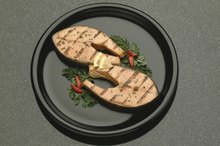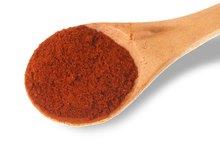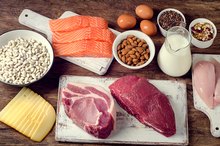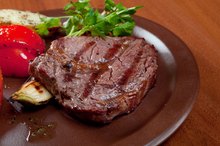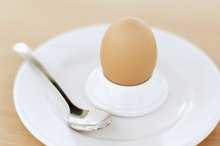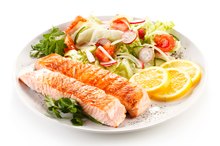What does fact checked mean?
At Healthfully, we strive to deliver objective content that is accurate and up-to-date. Our team periodically reviews articles in order to ensure content quality. The sources cited below consist of evidence from peer-reviewed journals, prominent medical organizations, academic associations, and government data.
- Academy of Nutrition and Dietetics: Build Muscle, No Steak Required
- Centers for Disease Control and Prevention: Nutrition for Everyone
- American Journal of Kidney Diseases: Effect of a High-Protein Diet on Kidney Function in Healthy Adults: Results From the OmniHeart Trial
- American Journal of Kidney Diseases: Effect of a High-Protein Diet on Kidney Function in Healthy Adults: Results From the OmniHeart Trial
The information contained on this site is for informational purposes only, and should not be used as a substitute for the advice of a professional health care provider. Please check with the appropriate physician regarding health questions and concerns. Although we strive to deliver accurate and up-to-date information, no guarantee to that effect is made.
The Benefits and Side Effects of High-Protein Diets
The typical diet consists of 12 to 18 percent of calories from protein. In a high-protein diet, 25 to 35 percent of calories come from protein 4. These diets have gained popularity as a method of weight loss; however, some health professionals are concerned that very high-protein diets may cause kidney damage.
Defining a High-Protein Diet
There are two common types of high-protein diets 15. The first is a diet in which some but not all carbohydrates are replaced with protein. These diets are usually low in fat. The other replaces almost all carbohydrates with protein and has a higher level of fat. Diets with extreme carbohydrate restriction lack important vitamins and minerals, including vitamin B, calcium and potassium. Ketosis may also occur with very low intakes of carbohydrate, such as less than 20 grams a day.
- There are two common types of high-protein diets 1.
- The other replaces almost all carbohydrates with protein and has a higher level of fat.
Benefits
What Is Protein Poisoning?
Learn More
A study published in “The Journal of Nutrition" in 2004 compared weight loss in a high-protein versus a high-carbohydrate diet. The high-protein diet consisted of 30 percent of calories from protein, while the high-carbohydrate diet consisted of 60 percent of calories from carbohydrates. Even though both groups experienced an average 11-pound weight loss at the conclusion of the study, several volunteers in the high-carbohydrate group dropped out due to complaints of hunger. None of those in the high-protein group dropped out due to hunger. The study concluded that high-protein diets are more satiating, which means dieters are more likely to stick with the meal plan and lose weight or improve other markers of health.
- A study published in “The Journal of Nutrition" in 2004 compared weight loss in a high-protein versus a high-carbohydrate diet.
- Even though both groups experienced an average 11-pound weight loss at the conclusion of the study, several volunteers in the high-carbohydrate group dropped out due to complaints of hunger.
Side Effects
Research published in the “American Journal of Kidney Diseases” in 2013 compared kidney function in two groups of otherwise healthy volunteers with prehypertension or early hypertension 4. Volunteers were fed either a high-protein diet, where 25 percent of calories were derived from protein, or a moderate-protein diet, where 15 percent of calories were derived from protein, for three weeks. At the end of the study, the kidneys of those eating the high-protein diet experienced a negative physiological response that may lead to kidney disease, although the short duration of the study does not provide conclusive evidence. For this reason, health professionals recommend obtaining a serum creatinine measurement and urinary dipstick test for proteinuria -- protein in the urine -- for those on a high-protein diet.
- Research published in the “American Journal of Kidney Diseases” in 2013 compared kidney function in two groups of otherwise healthy volunteers with prehypertension or early hypertension 4.
- For this reason, health professionals recommend obtaining a serum creatinine measurement and urinary dipstick test for proteinuria -- protein in the urine -- for those on a high-protein diet.
Implementation
Cayenne Pepper and Blood Sugar
Learn More
Large quantities of fat and carbohydrate can be stored in the body, available as a source of energy. On the other hand, protein stores are much smaller. It is beneficial to eat five to six small meals throughout the day, including protein with each. Sources of protein include one large egg, which contains 7 grams; a cup of milk, which provides 8 grams; 2 tablespoons of peanut butter, which also provides 8 grams, 1 cup of dried beans, which contains about 16 grams; or a 3-ounce piece of meat, which contains about 21 grams.
- Large quantities of fat and carbohydrate can be stored in the body, available as a source of energy.
- It is beneficial to eat five to six small meals throughout the day, including protein with each.
Related Articles
References
- Current Atherosclerosis Reports: Metabolic Effects of High Protein Diets
- Physicians Committee for Responsible Medicine: The Protein Myth
- USDA National Nutrient Database: Egg, Whole, Cooked, Hard-Boiled
- American Journal of Kidney Diseases: Effect of a High-Protein Diet on Kidney Function in Healthy Adults: Results From the OmniHeart Trial
- OB GYN News: Consider Renal Effects of High-Protein Diets
- Josse AR, Atkinson SA, Tarnopolsky MA, Phillips SM. Increased consumption of dairy foods and protein during diet- and exercise-induced weight loss promotes fat mass loss and lean mass gain in overweight and obese premenopausal women. J Nutr. 2011;141(9):1626-34. doi:10.3945/jn.111.141028
- Carreiro AL, Dhillon J, Gordon S, et al. The macronutrients, appetite, and energy intake. Annu Rev Nutr. 2016;36:73–103. doi:10.1146/annurev-nutr-121415-112624
- Ganesan K, Habboush Y, Sultan S. Intermittent fasting: The choice for a healthier lifestyle. Cureus. 2018;10(7):e2947. doi:10.7759/cureus.2947
- Pasiakos SM. Metabolic advantages of higher protein diets and benefits of dairy foods on weight management, glycemic regulation, and bone. J Food Sci. 2015;80 Suppl 1:A2-7. doi: 10.1111/1750-3841.12804
- Delimaris I. Adverse effects associated with protein intake above the recommended dietary allowance for adults. ISRN Nutr. 2013;2013:126929. doi:10.5402/2013/126929
- Bouvard V, Loomis D, Guyton KZ, et al. Carcinogenicity of consumption of red and processed meat. Lancet Oncol. 2015;16(16):1599-1600. doi:10.1016/S1470-2045(15)00444-1
- U.S. Department of Health, U.S. Department of Agriculture. Appendix 7. Nutritional Goals for Age-Sex Groups Based on Dietary Reference Intakes and Dietary Guidelines Recommendations - 2015-2020 Dietary Guidelines.
- Rodriguez NR, Dimarco NM, Langley S. Position of the American Dietetic Association, Dietitians of Canada, and the American College of Sports Medicine: Nutrition and athletic performance. J Am Diet Assoc. 2009;109(3):509-27. doi:10.1016/j.jada.2009.01.005
- Bray GA, Smith SR, de Jonge L, et al. Effect of dietary protein content on weight gain, energy expenditure, and body composition during overeating: a randomized controlled trial. JAMA. 2012;307(1):47-55. doi: 10.1001/jama.2011.1918. Erratum in: JAMA. 2012;307(10):1028.
- Centers for Disease Control and Prevention. Nutrition for Everyone: Protein.
- de Souza RJ, Bray GA, Carey VJ, et al. Effects of 4 weight-loss diets differing in fat, protein, and carbohydrate on fat mass, lean mass, visceral adipose tissue, and hepatic fat: results from the POUNDS LOST trial. Am J Clin Nutr. 2012;95(3):614-25. doi: 10.3945/ajcn.111.026328.
- Fox EA, McDaniel JL, Breitbach AP, Weiss EP. Perceived protein needs and measured protein intake in collegiate male athletes: an observational study. J Int Soc Sports Nutr. 2011;8:9. doi: 10.1186/1550-2783-8-9.
- Phillips SM, Zemel MB. Effect of protein, dairy components and energy balance in optimizing body composition. Nestle Nutr Inst Workshop Ser. 2011;69:97-108; discussion 108-13. doi: 10.1159/000329288.
- Te Morenga LA, Levers MT, Williams SM, et al. Comparison of high protein and high fiber weight-loss diets in women with risk factors for the metabolic syndrome: a randomized trial. Nutr J. 2011;10:40. doi: 10.1186/1475-2891-10-40.
Resources
Writer Bio
Renee Thompson who received her bachelor of science from Purdue University in dietetics/nutrition, fitness, and health. She works as a registered dietitian for Community Hospitals providing diabetes education, weight loss education and other nutrition expertise.
